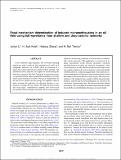| dc.contributor.author | Li, Junlun | |
| dc.contributor.author | Kuleli, Huseyin Sadi | |
| dc.contributor.author | Zhang, Haijiang | |
| dc.contributor.author | Toksoz, M. Nafi | |
| dc.date.accessioned | 2012-09-17T15:49:11Z | |
| dc.date.available | 2012-09-17T15:49:11Z | |
| dc.date.issued | 2011-12 | |
| dc.identifier.issn | 1070-485X | |
| dc.identifier.issn | 0016-8033 | |
| dc.identifier.uri | http://hdl.handle.net/1721.1/72995 | |
| dc.description.abstract | A new, relatively high frequency, full waveform matching method was used to study the focal mechanisms of small, local earthquakes induced in an oil field, which are monitored by a sparse near-surface network and a deep borehole network. The determined source properties are helpful for understanding the local stress regime in this field. During the waveform inversion, we maximize both the phase and amplitude matching between the observed and modeled waveforms. We also use the polarities of the first P-wave arrivals and the average S/P amplitude ratios to better constrain the matching. An objective function is constructed to include all four criteria. For different hypocenters and source types, comprehensive synthetic tests showed that our method is robust enough to determine the focal mechanisms under the current array geometries, even when there is considerable velocity inaccuracy. The application to several tens of induced microseismic events showed satisfactory waveform matching between modeled and observed seismograms. Most of the events have a strike direction parallel with the major northeast-southwest faults in the region, and some events trend parallel with the northwest-southeast conjugate faults. The results are consistent with the in situ well breakout measurements and the current knowledge on the stress direction of this region. The source mechanisms of the studied events, together with the hypocenter distribution, indicate that the microearthquakes are caused by the reactivation of preexisting faults. We observed that the faulting mechanism varies with depth, from strike-slip dominance at shallower depth to normal faulting dominance at greater depth. | |
| dc.description.sponsorship | United States. Dept. of Energy (Grant DE-FG3608GO18190) | |
| dc.language.iso | en_US | |
| dc.publisher | Society of Exploration Geophysicists | |
| dc.relation.isversionof | http://dx.doi.org/10.1190/geo2011-0030.1 | en_US |
| dc.rights | Article is made available in accordance with the publisher's policy and may be subject to US copyright law. Please refer to the publisher's site for terms of use. | en_US |
| dc.source | Society of Exploration Geophysicists | en_US |
| dc.title | Focal mechanism determination of induced microearthquakes in an oil field using full waveforms from shallow and deep seismic networks | en_US |
| dc.type | Article | en_US |
| dc.identifier.citation | Li, Junlun et al. “Focal Mechanism Determination of Induced Microearthquakes in an Oil Field Using Full Waveforms from Shallow and Deep Seismic Networks.” ©2011 Society of Exploration GeophysicistsGeophysics 76.6 (2011): WC87. | |
| dc.contributor.department | Massachusetts Institute of Technology. Department of Earth, Atmospheric, and Planetary Sciences | en_US |
| dc.contributor.department | Massachusetts Institute of Technology. Earth Resources Laboratory | en_US |
| dc.contributor.mitauthor | Li, Junlun | |
| dc.contributor.mitauthor | Kuleli, Huseyin Sadi | |
| dc.contributor.mitauthor | Zhang, Haijiang | |
| dc.contributor.mitauthor | Toksoz, M. Nafi | |
| dc.relation.journal | Geophysics | |
| dc.eprint.version | Final published version | en_US |
| dc.type.uri | http://purl.org/eprint/type/JournalArticle | en_US |
| eprint.status | http://purl.org/eprint/status/PeerReviewed | en_US |
| dspace.orderedauthors | Li, Junlun; Sadi Kuleli, H.; Zhang, Haijiang; Nafi Toksoz, M. | en |
| dc.identifier.orcid | https://orcid.org/0000-0002-4851-3089 | |
| dc.identifier.orcid | https://orcid.org/0000-0002-1875-1625 | |
| mit.license | PUBLISHER_POLICY | en_US |
| mit.metadata.status | Complete | |
